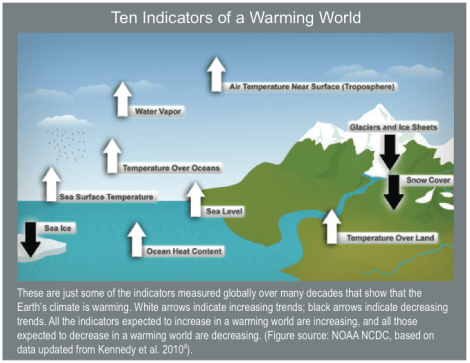Climate change is affecting you, right now. Yeah, you.
That’s the message from the Obama administration today. “Climate change, once considered an issue for a distant future, has moved firmly into the present,” says the latest National Climate Assessment, published by the White House. Every few years, by law, the federal government is required to publish such a report; this is the third and most comprehensive one put out. It’s a hefty catalogue of changes underway in America’s climate and weather — and of the changes we can expect to experience as greenhouse gases continue to turn the world into a more exotic and less welcoming place.
“Summers are longer and hotter, and extended periods of unusual heat last longer than any living American has ever experienced,” the report says. “Winters are generally shorter and warmer. Rain comes in heavier downpours. People are seeing changes in the length and severity of seasonal allergies, the plant varieties that thrive in their gardens, and the kinds of birds they see in any particular month in their neighborhoods.”
The report is somewhat similar to the assessments published once or twice a decade by the U.N. Intergovernmental Panel on Climate Change. Except that this report’s focus is solely on the U.S. And, unlike the IPCC reports, this one is actually a pleasure to look at — replete with graphics, animated gifs, and an easy-to-read website for those who would prefer to not slog through a huge .pdf or printed report.
The report divides climate impacts into 10 geographical regions: Northeast, Southeast and the Caribbean, Midwest, Great Plains, Southwest, Northwest, Alaska, Hawai’i and Pacific Islands, Oceans, Coasts.
“Some of the changes discussed in this report are common to many regions,” it states. “For example, large increases in heavy precipitation have occurred in the Northeast, Midwest, and Great Plains, where heavy downpours have frequently led to runoff that exceeded the capacity of storm drains and levees, and caused flooding events and accelerated erosion. Other impacts, such as those associated with the rapid thawing of permafrost in Alaska, are unique to a particular U.S. region. Permafrost thawing is causing extensive damage to infrastructure in our nation’s largest state.”
The report painstakingly outlines the impacts of climate change across the nation on water resources (water won’t always flow out of your tap when you want it to), energy (more blackouts), human health (what rhymes with mosquito?), transportation (traffic jams and transit outages, especially near coasts), agriculture (food is getting harder to find — unless you’re a plague of warmth-fostered invasive pests), forests (drought, fire, disease, and ravenous insects where trees once stood), and ecosystems (weird seasons are pushing wildlife into hostile ecological terrain).
And it contains 12 main findings — big-picture things that every American needs to understand about climate change:
1. Global climate is changing and this is apparent across the United States in a wide range of observations. The global warming of the past 50 years is primarily due to human activities, predominantly the burning of fossil fuels.
2. Some extreme weather and climate events have increased in recent decades, and new and stronger evidence confirms that some of these increases are related to human activities.
3. Human-induced climate change is projected to continue, and it will accelerate significantly if global emissions of heat-trapping gases continue to increase.
4. Impacts related to climate change are already evident in many sectors and are expected to become increasingly disruptive across the nation throughout this century and beyond.
5. Climate change threatens human health and well-being in many ways, including through more extreme weather events and wildfire, decreased air quality, and diseases transmitted by insects, food, and water.
6. Infrastructure is being damaged by sea level rise, heavy downpours, and extreme heat; damages are projected to increase with continued climate change.
7. Water quality and water supply reliability are jeopardized by climate change in a variety of ways that affect ecosystems and livelihoods.
8. Climate disruptions to agriculture have been increasing and are projected to become more severe over this century.
9. Climate change poses particular threats to Indigenous Peoples’ health, well- being, and ways of life.
10. Ecosystems and the benefits they provide to society are being affected by climate change. The capacity of ecosystems to buffer the impacts of extreme events like fires, floods, and severe storms is being overwhelmed.
11. Ocean waters are becoming warmer and more acidic, broadly affecting ocean circulation, chemistry, ecosystems, and marine life.
12. Planning for adaptation (to address and prepare for impacts) and mitigation (to reduce future climate change, for example by cutting emissions) is becoming more widespread, but current implementation efforts are insufficient to avoid increasingly negative social, environmental, and economic consequences.
So we have a lot to worry about. But the more than 300 experts who collaborated on the report, under the direction of the 60-member National Climate Assessment and Development Advisory Committee, have plenty of advice for taking action. A response strategies section includes a mitigation chapter (“the amount of future climate change will largely be determined by choices society makes about emissions,” it reminds us) and a chapter dealing with adaptation (“adaptation planning is occurring in the public and private sectors and at all levels of government,” it notes, “but few measures have been implemented.”)
This graphic shows some of the changes that we’ve unleashed upon the world, thanks to our appetites for fossil-fueled power:




